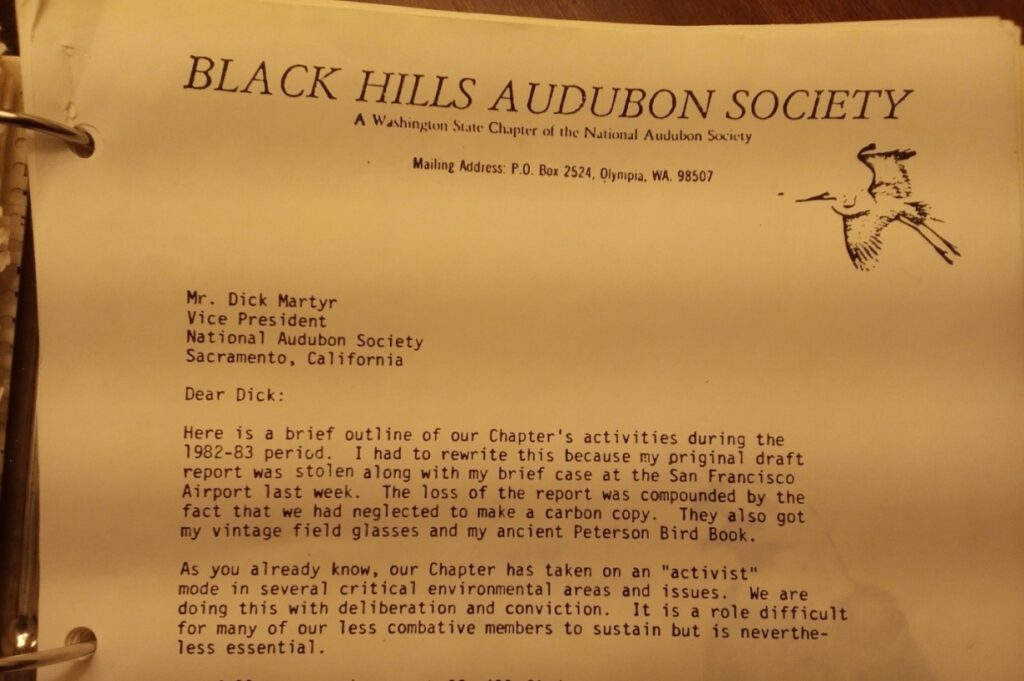
Kathleen Snyder
One thing really jumped out at me while I was reading our BHAS minutes from the 80’s – this was a time of environmental activism! All of the BHAS Board of Directors meeting agendas dealt with more than one environmental campaign.
I am reading through all the minutes of our organization in honor of our 50th anniversary. Last month I wrote about the 1970’s and how our founders built this chapter. This month will be about the 1980’s but I have an advantage; one Board member from that time, Susan Markey, is still active in our Conservation Committee so I was able to interview her.
The biggest surprise for me was that Grays Harbor County used to be included in our boundaries. At some point, it broke off and formed its own chapter but not until after 1989. I should mention that I am missing the minutes from 1981, 1983, 1984, and 1985. 1982 only has a summary without the minutes (see photo above).
It became apparent very quickly that BHAS was involved in many conservation campaigns spread throughout Washington and sometimes beyond. We were writing letters and lobbying politicians for issues such as California Condor Rehabilitation, a Hood Canal gravel quarry, the Commencement Bay superfund site, helping Portland Audubon with their effort to get the Marbled Murrelet listed as threatened (1987), and responding to a 1989 oil spill that affected wildlife on Vancouver and Protection Islands.
There was one issue that prevailed – pesticide use. The pesticide Endrin was a major focus of our organization. Banding together with Seattle and Yakima Chapters, an Endrin task force was formed in 1982 to lobby and then sue the Dept of Agriculture to get it banned. Other pesticides/herbicides that were mentioned through the years were 1080, methyl bromide, and Dinoseb. On a positive note, Board member Adrian Brown was awarded the Activist of the Year Award from National Audubon for his years of hard work on our Toxics Committee. By the way, the Endrin campaign was successful.
During this decade, protecting the Nisqually NWR from a deep water port proposed at DuPont was ongoing as was getting the Grays Harbor NWR formed (1990). The pieces finally fell together for the land swap resulting in Thurston County taking ownership of Glacial Heritage Preserve. The chapter joined a petition aimed at the US Fish and Wildlife Dept. to list the Spotted Owl as endangered. Capitol Lake restoration was mentioned for the first time.
The chapter changed office locations twice and, I am happy to report, switched to typewritten minutes in 1987. Jack and Ada Davis, also Board members, were awarded the Environmentalists of the Year award by Governor Spellman. Two problem situations among the minutes are worth mentioning. One was Audubon Nature Center (now Nisqually Reach Nature Center), which wasn’t affiliated with our chapter or National Audubon. People joined the center thinking they were joining BHAS. Also, National Audubon was often complained about as being unresponsive to chapters’ needs. In 1988, National went through a fiscal crisis and had to lay off 20 fulltime staffers. The National president at that time promised to make chapters the keystone of the organization going forward.
I found a couple of amusing entries that are worth sharing. The first, on a fundraising event, is, “We should make sure our volunteers follow health regulations so that ice used for storing milk doesn’t get served in drinks”. The second is, “The chapter is doing well, and yes, we can afford to buy chairs”. The only entry I found that was bird specific related that a Spotted Owl pair was found in the Elma/McCleary/Oakville region, not in old growth but in an area with big hemlocks that had mistletoe for nest platforms. I’ll be back next month with a summary of the 1990’s.
Photo credit: Photos by Kathleen Snyder. Above photo is areas of Chapter concern, 1982.








